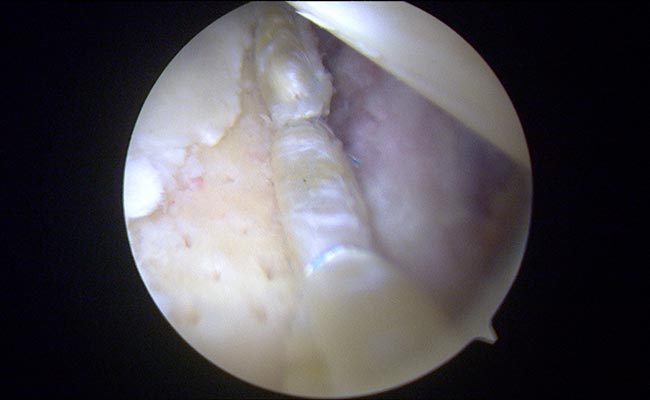In patients without arthritis, hip arthroscopy may offer relief from hip pain with a minimally invasive surgical treatment option that can also improve function and movement. For those who have more extensive injury and a diagnosis of arthritis, total hip replacement is the preferred surgical approach.

Hip Arthroscopy
Hip arthroscopy is a minimally invasive surgery in which only two or three small incisions are utilized to insert a small camera and miniature surgical instruments into the hip joint to repair damaged cartilage and bone malformations. The operation typically takes about 2 hours and patients go home the same day. Patients can begin weight bearing 2 days to 8 weeks after surgery.
FAI is one of the most common problems treated by hip arthroscopy. FAI (Femoroacetabular Impingement) is when there is abnormal contact between the hip joint socket and the femur (thigh bone) and is treated by reshaping the bone to remove the abnormal contact. This abnormal contact can cause cartilage damage in the joint and damage to the labrum. The labrum is a ring of cartilage that sits on the edge of the hip socket and forms a seal on the head of the femur. Torn labrums are treated by fixating it back to the rim of the hip socket, removing it completely, or by reconstructing it with new tissue. Cartilage damage is treated by removing the damaged cartilage, allowing new healthy cartilage to grow. These procedures have been shown to greatly reduce pain and increase function in the hip.
The MASH Study Group
Arthroscopy is a relatively new and growing field in surgery. Dominic Carreira currently leads a research group of expert hip arthroscopists looking for ways to provide quality improvements in hip arthroscopy. Visit MASHstudy.com to learn more about the exciting research conducted by Dr. Carreira.
Osteoarthritis
Osteoarthritis is a painful wear and tear condition that destroys joint cartilage. It can be caused by trauma, repetitive movement, or even for no apparent reason. Hip arthroscopy is a preservation method for pre-osteoarthritic hips. It does not cure osteoarthritis; however, it may help prevent its progression. If hip osteoarthritis has advanced into later stages, hip arthroscopy is not indicated and may actually make matters worse. Under these circumstances total hip replacement is the best option.
Total Hip Replacement
Hip replacement is an invasive procedure that involves large incisions, removal of the head of the femur as well as damaged bone and cartilage from the hip socket and replacement with prosthesis. The operation typically takes about 2 hours and patients are hospitalized for 1 to 3 days after surgery. After surgery most patients use a walker or cane for about 2 to 4 weeks.
The results of total hip replacement vary depending on the individual’s age, weight, activity level, lifestyle, and medical conditions. Typically a hip replacement results in less pain and better hip function. The implants used in hip replacement do have a limited life expectancy. A joint implant’s longevity will vary in every patient, but they typically last about 20 years.
Joint replacement technology continues to advance rapidly. Prostheses are being developed through new means such as 3D printing, so we can expect the hip replacement surgery to keep getting better.


